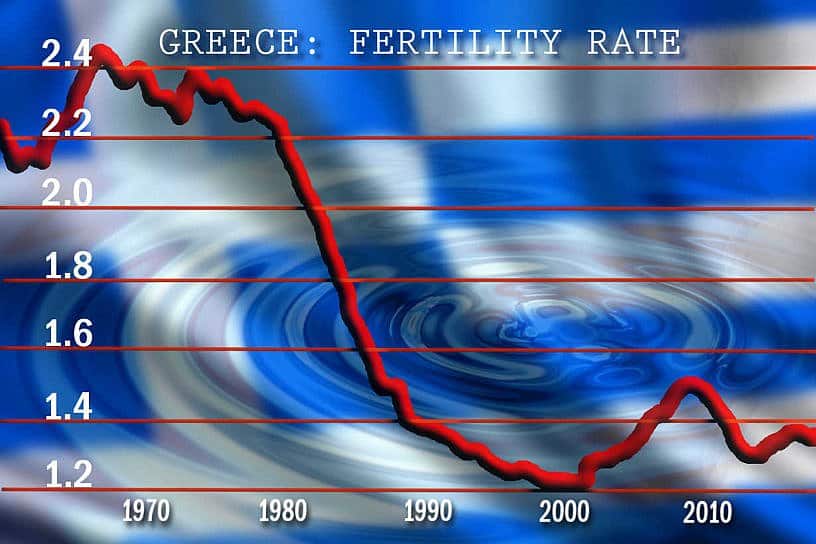A Demographic Reality, And There Is No Cure
Have you ever dropped a pebble down a well, and waited to hear the splash? That simple act brings forth certain ramifications that tell us that Greece will not survive as we know it today; the beautiful land will still be there, but its people will not be Greeks – except perhaps in name.
Consider the act of dropping the pebble: From the moment you release it, the results are inevitable, predictable, and irreversible. There is no turning back – the pebble will take its time and fall to the bottom and splash in the water, and there is nothing that can be done to stop, or slow down, or hurry its fall, let alone reverse that action. Equally important, is the definite amount of time that passes from the moment of release, until the result (the “splash”) occurs. The same holds true for what we now call – using a Greek word – “Demographics.” Today’s newborn babies play the same role as the pebble, and they will also inevitably, predictably, and irreversibly add their “splash,” that is, create their own babies in turn, a generation later.
A simple, logical concept is in order here: A couple, to “replace” themselves exactly, must produce a “pair” of children. So, the “replacement rate” would two children per woman in her lifetime. (Professional Demographers use the slightly higher number 2.1 as the normal “fertility rate.”)
A classic case of not meeting this “replacement rate” is China: From 1949 until 1979, under Mao’s edicts, China had a “fertility rate” of 6.0, and its population doubled, from about half a Billion to just under one billion souls. Realizing the calamity of overpopulation, the Chinese government in 1980 passed a draconian edict: “One child per couple!” This has resulted in the reduction of the Chinese “fertility rate” to only 1.6 children per woman.
But it takes a very long time, typically more than one generation, for the effects of changed fertility rates to make an impact. A child born today must reach maturity, a generation later, before it can produce a child in turn. This is the time it takes the pebble, from its release until it hits the water. The legacy of the “pebble,” which could not be stopped, meant that the 6 Chinese children born before the edict were still growing, and a generation after the edict was contributing at least 1.6 children per woman. So today, almost two generations later, China’s population, despite this sharply enforced, much lower “fertility rate,” has reached 1.4 Billion! India, soon to be – or perhaps already is – the most populous nation on Earth, has the same overpopulation problem as China, and tried briefly even harsher measures – to discover that of all the social experiments it tried, education of women was the most effective. (It’s “fertility rate” is less than half what it was in the past, but it’s still at 2.4, partly due to the significant level of illiteracy in many of its provinces.)
Greece has the opposite problem – a low “fertility rate,” but it also faces its own upcoming long-term impacts. Today’s Greece is a modern, highly educated, relatively economically comfortable society. As India’s experiments in the 20th Century discovered, there is a direct connection between education and the “fertility rate.” Educated, working women in affluent cultures are having fewer babies and starting later in life. Greeks take great pride in nurturing and supporting their children’s education. As a result, Greece’s current “fertility rate” is one of the lowest in the world, at only about 1.3 children per woman. What’s more, it’s been at that level for the past 25 years – a whole generation.
What does this mean for Greece? Well, clearly, Greece, having far below the 2.1 replacement rate for a generation, would naturally be starting, just about now, to see a diminishing of its population. Greece is not alone in this respect; most modern industrialized countries, with the well-educated populace and good health care and fine sanitary conditions, are also below the replacement rate. Their governments are aware of the dangers of under-population, e.g., one consequence is that there will not be enough workers in the future to support the always larger number of aging retirees. So, these governments, each in its own way, is trying to do the opposite of China: to persuade its people to have more children! This is done via propaganda, social campaigns, provisions of economic benefits (e.g., tax breaks, bonuses, or other perquisites for large families, etc.)
But Greece’s core problem is basically the same – even though in reverse – as that of China and India: The inexorable result of the unstoppable “falling pebble.” The low fertility rate of the past 25 years will play out its role over time, no matter what. The babies of the 1970s and 1980s opted to have only half the children their mothers had. And, the non-born children of today will obviously not produce any of their own, a generation from now. Even if, somehow, Greece’s fertility rate were to double tomorrow, by some miracle suddenly, it cannot change or reverse the decline, for at least a couple of generations.
So, what will happen to Greece in a generation or so? Greece is one of the most attractive places on Earth. Our ancestors believed that their gods, who could have chosen anywhere to live, wisely selected Greece. So, people from elsewhere will always come to stay and live in this beautiful land, with its sparkling sea and its majestic mountains and magic islands. The overall population will not decline. But, with the fertility rate at such low levels, who will those people be? They won’t be Greeks!
But, to end this on a positive note, there’s always a silver lining to every cloud. With the current figures of 7.8 Greek children born, for every 12 passings, it means that there’s the accumulated wealth of those 12, to be divided between only 7.8 young inheritors, thus more for each of them, a nice number to be enjoyed by the smaller, new generation. Opa! Ευχαριστώ (thanks) “pappou!”



